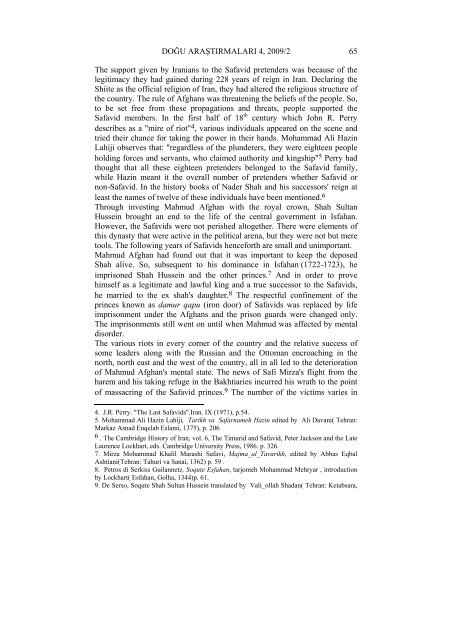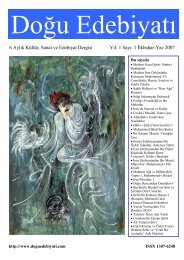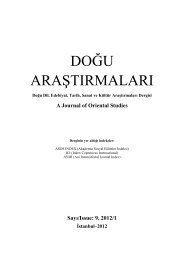A Journal of Oriental Studies Sayı/Issue - Doğu Edebiyatı
A Journal of Oriental Studies Sayı/Issue - Doğu Edebiyatı
A Journal of Oriental Studies Sayı/Issue - Doğu Edebiyatı
You also want an ePaper? Increase the reach of your titles
YUMPU automatically turns print PDFs into web optimized ePapers that Google loves.
DOĞU ARAŞTIRMALARI 4, 2009/2 65<br />
The support given by Iranians to the Safavid pretenders was because <strong>of</strong> the<br />
legitimacy they had gained during 228 years <strong>of</strong> reign in Iran. Declaring the<br />
Shiite as the <strong>of</strong>ficial religion <strong>of</strong> Iran, they had altered the religious structure <strong>of</strong><br />
the country. The rule <strong>of</strong> Afghans was threatening the beliefs <strong>of</strong> the people. So,<br />
to be set free from these propagations and threats, people supported the<br />
Safavid members. In the first half <strong>of</strong> 18 th century which John R. Perry<br />
describes as a "mire <strong>of</strong> riot" 4 , various individuals appeared on the scene and<br />
tried their chance for taking the power in their hands. Mohammad Ali Hazin<br />
Lahiji observes that: "regardless <strong>of</strong> the plunderers, they were eighteen people<br />
holding forces and servants, who claimed authority and kingship" 5 Perry had<br />
thought that all these eighteen pretenders belonged to the Safavid family,<br />
while Hazin meant it the overall number <strong>of</strong> pretenders whether Safavid or<br />
non-Safavid. In the history books <strong>of</strong> Nader Shah and his successors' reign at<br />
least the names <strong>of</strong> twelve <strong>of</strong> these individuals have been mentioned. 6<br />
Through investing Mahmud Afghan with the royal crown, Shah Sultan<br />
Hussein brought an end to the life <strong>of</strong> the central government in Isfahan.<br />
However, the Safavids were not perished altogether. There were elements <strong>of</strong><br />
this dynasty that were active in the political arena, but they were not but mere<br />
tools. The following years <strong>of</strong> Safavids henceforth are small and unimportant.<br />
Mahmud Afghan had found out that it was important to keep the deposed<br />
Shah alive. So, subsequent to his dominance in Isfahan (1722-1723), he<br />
imprisoned Shah Hussein and the other princes. 7 And in order to prove<br />
himself as a legitimate and lawful king and a true successor to the Safavids,<br />
he married to the ex shah's daughter. 8 The respectful confinement <strong>of</strong> the<br />
princes known as damur qapu (iron door) <strong>of</strong> Safavids was replaced by life<br />
imprisonment under the Afghans and the prison guards were changed only.<br />
The imprisonments still went on until when Mahmud was affected by mental<br />
disorder.<br />
The various riots in every corner <strong>of</strong> the country and the relative success <strong>of</strong><br />
some leaders along with the Russian and the Ottoman encroaching in the<br />
north, north east and the west <strong>of</strong> the country, all in all led to the deterioration<br />
<strong>of</strong> Mahmud Afghan's mental state. The news <strong>of</strong> Safi Mirza's flight from the<br />
harem and his taking refuge in the Bakhtiaries incurred his wrath to the point<br />
<strong>of</strong> massacring <strong>of</strong> the Safavid princes. 9 The number <strong>of</strong> the victims varies in<br />
4. J.R. Perry. "The Last Safavids".Iran. IX (1971), p.54.<br />
5. Mohammad Ali Hazin Lahiji, Tarikh va Safarnameh Hazin edited by Ali Davani( Tehran:<br />
Markaz Asnad Enqelab Eslami, 1375), p. 206<br />
6 . The Cambridge History <strong>of</strong> Iran, vol. 6, The Timurid and Safavid, Peter Jackson and the Late<br />
Laurence Lockhart, eds. Cambridge University Press, 1986. p. 326.<br />
7. Mirza Mohammad Khalil Marashi Safavi, Majma_al_Tavarikh, edited by Abbas Eqbal<br />
Ashtiani(Tehran: Tahuri va Sanai, 1362) p. 59 .<br />
8. Petros di Serkiss Guilannetz, Soqute Esfahan, tarjomeh Mohammad Mehryar , introduction<br />
by Lockhart( Esfahan, Golha, 1344)p. 61.<br />
9. De Serso, Soqute Shah Sultan Hussein translated by Vali_ollah Shadan( Tehran: Ketabsara,





